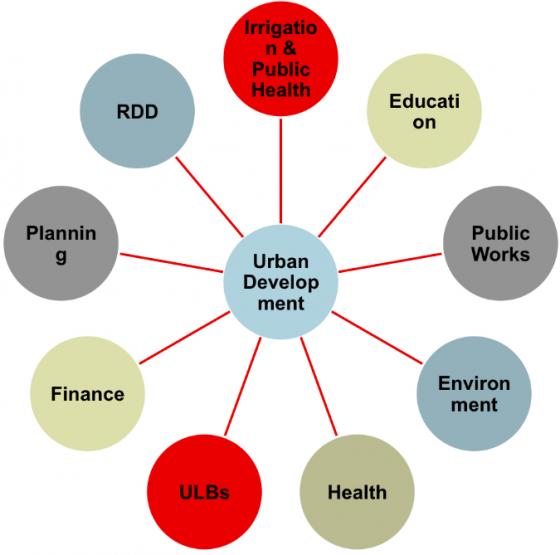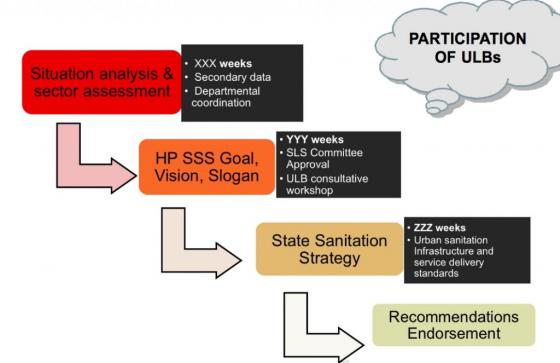| Disclaimer: Links within the texts to additional information, concepts and tools are SSWM editor’s inputs and might not represent the view or practices of GIZ. |
Water supply and sanitation were added to India’s national agenda during its first five-year plan period. Yet until 1979, relatively negligible investment was made within the sector. Since 1980, which also marked the start of the International Decade for Drinking Water Supply and Sanitation, the government substantially increased its financial commitment to the sector, but mainly to rural sanitation. Urban sanitation remained the poor cousin to urban water supply both on paper – where it was generally subsumed under water supply – and also in practice where the bulk of investment was allocated towards and spent on large infrastructure projects for water. One reason was that while water was already recognised as a ‘public good’, safe sanitation was not yet given the same status.
A comprehensive policy framework for sanitation provision emerged in 2008, when the Ministry of Urban Development launched the National Urban Sanitation Policy (NUSP) to guide the provision of urban sanitation in the country.
As the government itself notes, the NUSP signified a watershed in India’s urban development since it not only accorded national recognition separately to urban sanitation (separate from water), but also signalled to states and cities the urgency needed in planning and implementing measures for improving urban sanitation in a targeted manner (SACOSAN 2011).
Sanitation in India is a state subject. State-level steering committees and urban departments play the role of guidance and support to Urban Local Bodies (ULBs), which are responsible for final implementation of sanitation at the local level. ULBs are mandated to undertake planning, design, implementation, operation and maintenance of water supply and sanitation services in cities and towns. Currently, 29 states and union territories, out of a total of 35, are engaged in preparing State Sanitation Plans and 158 cities have taken the initiative to make City Sanitation Plans (DASRA 2012).
Currently, the State Sanitation Strategy extends into 8 States (Himachal Pradesh, Chhattisgarh, Andhra Pradesh, Kerala, Maharashtra, Karnataka, Uttar Pradesh & Madhya Pradesh). It can be emphasised that the State Sanitation Strategies will help in the following ways:
- Meeting the service level benchmark on drinking water supply (see also chapters water sources, water purification, water distribution) and sanitation services (see also wastewater collection), sewerage, wastewater treatment, solid waste management, and storm water drainage (see also stormwater management and open channels and drains).
- Analyse and respond to the state level situation, challenges and issues.
- Improving city sanitation rating and ranking (see National Award Scheme for Sanitation for Indian Cities).
- Mobilising funds through flagship programs such as JNNURM, RAY (see also the chapters financing and economic tools in wastewater treatment).
- Linkages with performance based grants under 13th Finance Commission.
- Improving public health and environmental outcomes (see also invalid link and environmental issues).
Adapted from NUSP (2008)
According to NUSP, State Sanitation Strategy will be prepared within one year and outlined for a period of 30 years for the State. It should be with the active participation of the Urban Local Bodies and other para-statal agencies so that a viable State Sanitation Strategy can be prepared. Status of service levels in environmental sanitation includes water supply (see also chapters water sources, water purification and water distribution), sanitation (see also wastewater collection, sanitation systems, wastewater treatment), solid waste management and drainage (see also stormwater management) and their related aspects such as management (e.g. participatory monitoring and evaluation), design standards in water supply, technology usage, construction, operation and maintenance, sanitation implication on health, awareness on sanitation and hygiene (see also awareness raising in wastewater treatment, demand creation and invalid link), environmental issues, financing, cost recovery aspects (e.g. invalid link in wastewater treatment and water charges), etc. are analysed in situation analysis to provide comprehensive assessment of the existing urban sanitation situation across the state.

State Sanitation Strategy Key Players. Source: GIZ (2012)
Like in the national policy, state strategies are recommended to detail out the following generic headings or areas requiring attention:
A) Define State Sanitation Strategy - Goals and Vision
The State Sanitation Strategy is framed looking at the requirements of urban state, emerging out from situational analysis and also as per the requirements of NUSP (see NUSP overview) through extensive consultations with all the stakeholders (see also stakeholder identification). The Strategy defines the state targets, unified approach and resources that will be necessary to enable the ULBs to achieve strategy goals in a systematic and time-bound manner. The strategy also mandates and guides ULBs to develop City Sanitation Plans (CSPs) detailing how to plan for delivering sanitary outcomes defined in the State Urban Sanitation Strategy (see also City Sanitation Plans according to the NUSP). This should be in coordination with other line departments to ensure a well-collaborated approach engaging all stakeholders including governmental and non-governmental service providers (see also the chapter exploring, stakeholder analysis, demand creation and decision making). Other departments and institutions carrying out sanitation related projects in urban areas are also recommended to follow this strategy. Goals are based on core values on equity, transparency, convergence, departmental coordination, and sustainability of actions taken to improve the sanitation conditions of the sate (see also sustainable sanitation). A vision for the state is defined during this process.

Timeline for SSS structuring. Source: GIZ (2012)
B) Orientation of Institutional Mechanisms
The existing multi-tier (State-District-City/Town) institutional arrangement shall be oriented within the scope of increased devolution initiated over the last two years, with clear assignment of roles, responsibilities to the institutions. State Urban Sanitation Strategies (SUSS) must ensure clear ULB responsibility as envisaged in the 74th Constitutional Amendment (CA). Where this is partial or incomplete, states will need to make concerted efforts to devolve powers, roles and responsibilities along with financial and personnel resources necessary for ULBs to discharge their functions (see also invalid link and invalid link in wastewater collection). Alongside, the ULBs will also have to be accorded wide-ranging powers over agencies that currently carry out sanitation related activities in the city but are not directly accountable to them, e.g. para-statals and PHEDs.
C) Planning and Financing
ULBs will need to be made responsible for planning and financing public infrastructure, and leveraging such private investments as may be required for achieving outcomes (as stated in their State Strategies) (see also planning and process tools and financing). The problem of shortage of funds needs to be factored in. In this regard, States will need to devolve adequate and predictable resources to ULBs including setting tariffs (see also water pricing general, inter-governmental fiscal transfers (see also government contributions) and devising targeting of subsidies to the poorest of the poor households. The issue of recovery of O&M cost and through the introduction of use charges collection of dues (see also water charges) needs to be emphasised as a means of ensuring accountability as well as financial sustainability. In doing so, State Government’s support to ULBs will need to be increasingly re-oriented to reward the achievement of outcomes (moving way from input, process and hardware funding per se). State governments will also be encouraged to launch awards for best performing cities to bring about a competitive spirit in achieving total sanitation by cities (see also National Award Scheme for Sanitation for Indian Cities). Considerable coordination will also be required across other government agencies and institutions, private and community institutions – to highlight the priority to sanitation, as well as in planning and implementation of programs.
C) Implementation
The state will draft and issue guidelines for the ULBs in sanitation management covering, environmental standards (like PCB effluent standards for discharge to land and water), Public Health indicators and standards (like incidence of diarrhoea, Water Quality standards for faecal coliform) and safety standards for workers involved in safe sanitary disposal and management including identification of hazards and minimum worker-safety and process-safety standards to be maintained (see also invalid link and planning for implementation tools). The ULB concerned will be accountable with regard to service delivery and for assets created and managed as part of the initiative. States are recommended to not just emulate but set their standards higher than the national standards in order to encourage its institutions and citizens to target higher standards of public health and environment.
D) Reaching the Un-served Populations and the Urban Poor at the State Level
States will need to resolve tenure, space and affordability constraints to providing individual sanitation facilities preferentially, and community facilities where individual provision is not feasible. The provisioning of basic sanitation should be de-linked from the issues of land tenure. Every urban dweller should be provided with minimum levels of sanitation, irrespective of the legal status of the land in which he/she is dwelling, possession of identity proof or status of migration. However, the provision of basic services would not entitle the dweller to any legal right to the land on which he/she is residing. At least 20% of the funds under the sanitation sector should be earmarked for the urban poor. The issues of cross subsidising the urban poor and their involvement in the collection of operation and maintenance charges should be considered. States will need to issue guidelines to support cities in adopting participatory approaches to community sanitation (e.g. community-led urban environmental sanitation), and rational planning for appropriate and adequate sanitation for floating population, institutions and public place workers (see also creating an enabling environment in wastewater collection), with explicit recognition of cost recovery for sustainable management, service delivery and repairs and maintenance. Special role of NGOs and CBOs needs to be recognized in this respect, especially for community sanitation facilities.

A slum area in Chennai. Source: S. SADHKARAN (n.y.)
E) Service Delivery in Cities
ULBs will need to be responsible for asset-creation and managing systems including service delivery. In this context, the ULB may bring in public, private and community agencies and groups to provide services on its behalf. But the final accountability with regard to performance in sanitation will have to be that of the ULB. Departments and para-statals currently carrying out these responsibilities will need to be accountable to the respective ULBs (including for example, financing through the ULBs). The State governments will need to make explicit directions in this regard, including roles for NGOs and CBOs and the urban poor.
F) Regulation of Cities and Within Cities
State Strategies will need to dwell on this issue carefully – strengthening existing state level institutions that are charged with ensuring compliance of ULBs to environmental standards (e.g. State Pollution Control Boards), health outcomes (e.g. Health Departments), and Service Delivery Standards (e.g. State Urban Departments). Wherever these responsibilities or action on deviance are not spelt out clearly, the state strategy will need to make these clear. The strategy will also have to identify the ULB as having the key regulatory remit over all properties and agencies/households in the city in respect of outcomes and process standards stipulated by it.
G) Monitoring & Evaluation at the State and City Levels
The State government will be responsible for monitoring and evaluation of its cities’ performance, and hence needs to devise data collection and process documentation using indicators to measure progress and performance (see also exploring and ensuring sustainability. ULBs in turn need to track compliance of households (establishments, etc.) with outcomes and process standards that it has adopted. Introducing citizens’ report cards, citizens’ monitoring committees, self-assessment system, inter-city competitions, etc. will be considered (see also participatory monitoring and evaluation). NGOs and CBOs will also play key roles in monitoring and evaluation.
H) Capacity Building & Training
The state strategy needs to identify agencies that will train its state level, ULB personnel and orientation of elected representatives. These agencies could be specialist agencies of the state government, and/or NGOs and private sector organisations. This will also need to focus on capacity building, i.e. not just training but also development of systems and capacities of ULBs in sanitation (see also invalid link in wastewater treatment), in line with the Urban Sector Reforms that the state may be implementing. ULBs will need to provide training on sanitation to their own staff using state level resource agencies (see also train the trainers and SSWM courses). They will need to utilise Government of India and State Government Schemes for training and capacity building in order to achieve this.
Squatting Rights. Access to toilets in Urban India
Himachal Pradesh State Sanitation Strategy. First State level Sanitation Committee Meeting in Shimla
A slide show presenting the strategies adopted by State of Himachal Pradesh for its State Sanitation Strategy.
GIZ (2012): Himachal Pradesh State Sanitation Strategy. First State level Sanitation Committee Meeting in Shimla. Eschborn: Deutsche Gesellschaft fuer Internationale Zusammenarbeit (GIZ)National Urban Sanitation Policy
This document describes the framework set by the Government of India to meet its overall goal of transforming urban India into community-driven, totally sanitised, healthy and liveable cities and towns.
MOUD (2008): National Urban Sanitation Policy. New Delhi: Ministry of Urban Development (MoUD). URL [Visita: 18.06.2019]Enhanced Quality of Life through Sustained Sanitation. India Country Paper. The IV South Asia Conference on Sanitation
National Urban Sanitation Policy
This document describes the framework set by the Government of India to meet its overall goal of transforming urban India into community-driven, totally sanitised, healthy and liveable cities and towns.
MOUD (2008): National Urban Sanitation Policy. New Delhi: Ministry of Urban Development (MoUD). URL [Visita: 18.06.2019]Madhya Pradesh. Integrated Urban Sanitation Programme
This document gives an idea on the Integrated Urban Sanitation Programme in Madhya Pradesh for designing and implementing integrated citywide sanitation plans focusing on all aspects of sanitation with support from the local communities and other stakeholders.
GOMP (2009): Madhya Pradesh. Integrated Urban Sanitation Programme. Bhopal: Urban Administration and Development Department, Government of Madhya Pradesh URL [Visita: 27.10.2012]Odissha Urban Sanitation Strategy
This document describes the State Sanitation Strategy for the state Odissha. It gives detailed descriptions of specific institutional arrangement the Odissha Government has done for implementing the state sanitation strategy.
GOD (2011): Odissha Urban Sanitation Strategy. Bhubaneswar: Housing and Urban Development Department, Government of Odisha URL [Visita: 27.10.2012]Tripura Urban Sanitation Strategy. Draft
This document gives guidelines taken by Tripura state to support municipal to make concerted efforts to devolve powers, roles and responsibilities along with financial and personnel resources necessary for ULBs to promote sustainable sanitation.
GOT (2011): Tripura Urban Sanitation Strategy. Draft. Agartala: Urban Development Department, Government of Tripura URL [Visita: 27.10.2012]Urban Policy and Action Plan for Kerala
Reforms in state government to address increasing problems in cities of Kerala and institutionalising the actions is described in this document.
GOK (2002): Urban Policy and Action Plan for Kerala. Thiruvananthapuram: Urban Development Department, Government of Kerala URL [Visita: 27.10.2012]Sanitation Straegies in Karnataka: A Review
Various strategies are designed by the Government of India and the state governments to achieve the provision of sanitation. It is observed that the strategies involving non-government organisations are more effective than the ones involving exclusively the state in promotion of sanitation.
VEERASHEKHARAPPA BHIDE, S. (2009): Sanitation Straegies in Karnataka: A Review. Bangalore: The Institute for Social and Economic Change URL [Visita: 12.11.2012]India, Urban Sanitation, and the Toilet Challenge
This research brief builds upon a literature review and stakeholder interviews in India on urban sanitation to examine the public policy landscape for sanitation innovation in the country.
ELLEDGE, M.F. MCCLATCHEY, M. (2013): India, Urban Sanitation, and the Toilet Challenge. Durham: Research Triangle Institute (RTI) International URL [Visita: 25.11.2013]Himachal Pradesh State Sanitation Strategy. First State level Sanitation Committee Meeting in Shimla
A slide show presenting the strategies adopted by State of Himachal Pradesh for its State Sanitation Strategy.
GIZ (2012): Himachal Pradesh State Sanitation Strategy. First State level Sanitation Committee Meeting in Shimla. Eschborn: Deutsche Gesellschaft fuer Internationale Zusammenarbeit (GIZ)Support in the preparation of State Sanitation Strategies (SSS) in selected states. PWD officers training in Goa
A slide show presenting the strategies that can be adopted by State of Goa for its State Sanitation Strategy.
GIZ (2012): Support in the preparation of State Sanitation Strategies (SSS) in selected states. PWD officers training in Goa. Eschborn: Deutsche Gesellschaft fuer Internationale Zusammenarbeit (GIZ)National Urban Sanitation Policy
This document describes the framework set by the Government of India to meet its overall goal of transforming urban India into community-driven, totally sanitised, healthy and liveable cities and towns.
MOUD (2008): National Urban Sanitation Policy. New Delhi: Ministry of Urban Development (MoUD). URL [Visita: 18.06.2019]Open Defecation Free Tamil Nadu by 2014: Vision, Challenges and Way. Consultative Workshop on Sanitation Policy at Chennai in Tamil Nadu
To make Tamil Nadu open defecation free, a goal and vision for safe sanitation practices in Tamilnadu is defined and the work progress is explained in this presentation.
SETHURAMAN, S. (2012): Open Defecation Free Tamil Nadu by 2014: Vision, Challenges and Way. Consultative Workshop on Sanitation Policy at Chennai in Tamil Nadu. Chennai: Institute for Financial Management and ResearchWorkshop on Formulation of State Sanitation Strategy & Making of City Sanitation Plans
This slideshow from a workshop on Formulation of State Sanitation Strategy & Making of City Sanitation Plans presents the USAID FIRE (D) Approach for Preparing City Sanitation Plans.
USAID INDIA (2010): Workshop on Formulation of State Sanitation Strategy & Making of City Sanitation Plans. Washington, D.C.: U.S. Agency for International Development URL [Visita: 06.11.2012]http://www.urbanindia.nic.in
This is the web page of the Ministry of Urban Development of the Government of India. The Ministry of Urban Development is responsible for formulating policies, supporting and monitoring programmes and coordinating the activities of various Central Ministries, State Governments and other nodal authorities in so far as they relate to urban development issues in the country.
http://www.indiasanitationportal.org
The India Sanitation Portal is an open, inclusive, web-based platform for sharing sanitation knowledge amongst practitioners and the general public. It aims to draw on the rich experience of sanitation-sector experts, package their knowledge and add value to it through technology and then disseminate it to a larger audience through the internet.
http://www.youtube.com/
The film “Towards Clean Cities: Addressing Sanitation in Urban India” advocates the need for a holistic approach to urban sanitation instead of focusing on fragmented approaches to the sanitation problem in urban areas, an approach which looks at creating open defecation free cities is advocated.
http://www.youtube.com
The short documentary “India's sanitation crisis” shows the sanitation crisis in urban areas, particularly in slums.


